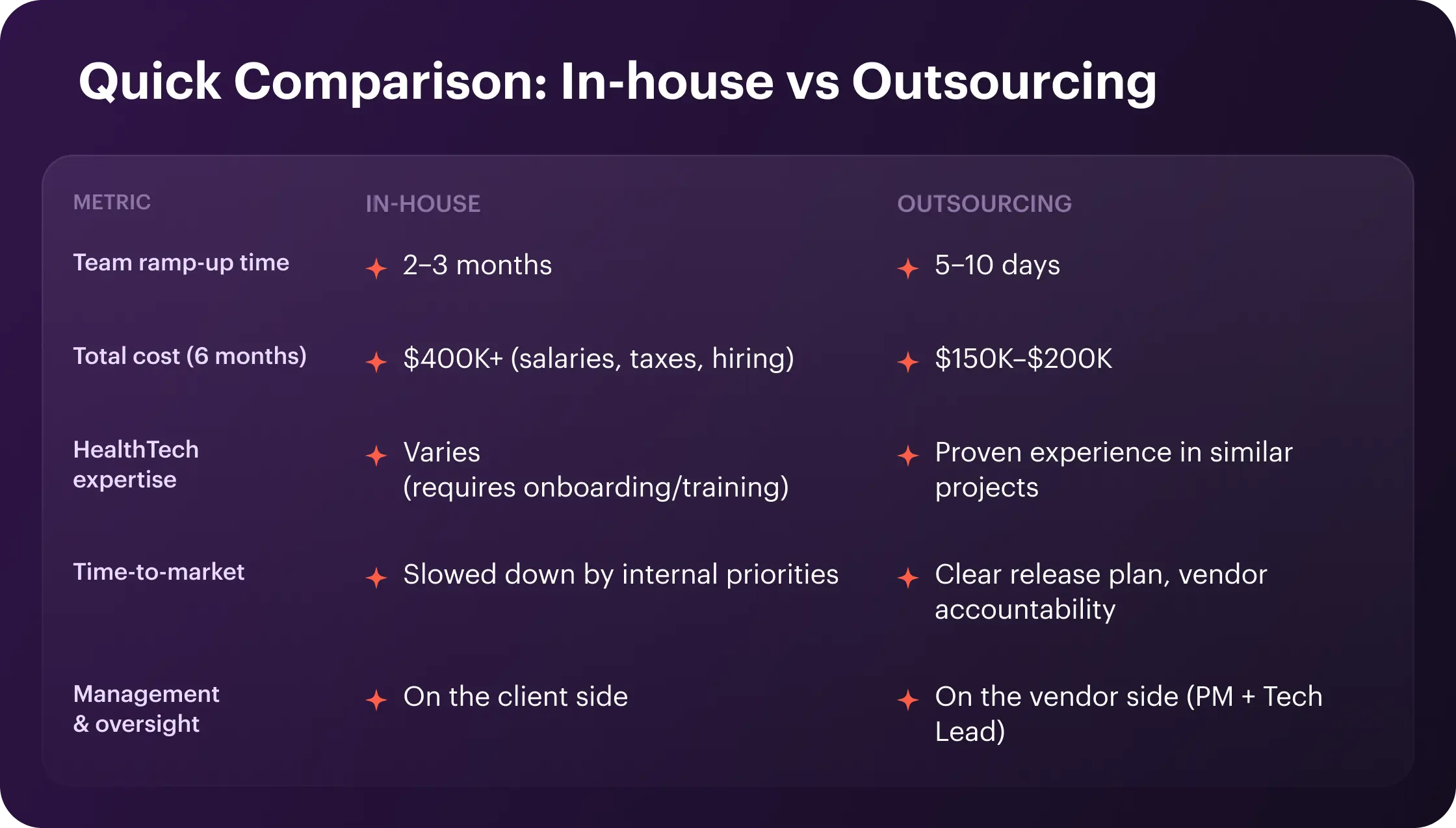Why Outsourcing Beats In-House in U.S. HealthTech Projects: A Case Rooted in Clinical Data Monitoring

In the U.S. HealthTech industry, time to market, data security, and regulatory compliance are non-negotiable. But even well-funded teams with in-house developers often find themselves in a quandary: they are overwhelmed by competing priorities, lack industry expertise, or can't move fast enough to meet release deadlines.
This article discusses how outsourcing helped a U.S. healthcare company build a clinical data monitoring tool faster, safer, and with tighter controls than an in-house team could have done. It also explores why outsourcing is often the more strategic choice in 2025.
The Project Context
The client is a U.S. HealthTech company with an in-house backend system that is already up and running. They needed to build a clinical data monitoring interface that would:
- Integrate seamlessly with existing infrastructure.
- Handle sensitive patient data under HIPAA.
- Offer a user-friendly dashboard for trial administrators and clinicians.
- Be delivered quickly, without disrupting the internal roadmap.
Their internal team was focused on core backend infrastructure. While capable, they didn’t have the bandwidth or specific expertise in data visualization and regulated interface design. The client needed a fast, compliant, and scalable solution—without hiring full-time.
Key point: This wasn’t a team that “couldn’t do it.” It was a team that didn’t have the right bandwidth or specialized roles at the right time. The result? Risk of project delays and regulatory exposure.
What an In-House Team Would Require
To build and maintain this type of clinical data monitoring system internally, a company would need:
- 2+ front-end engineers experienced in PHI-safe architecture.
- 1 UX designer familiar with clinical interfaces and dashboards.
- 1 DevSecOps engineer to manage secure infrastructure.
- 1 project manager with experience in HIPAA/FDA-compliant software delivery.
- Time and budget to recruit, onboard, and retain this team.
That’s at least 4–5 full-time hires. In 2025, hiring a senior developer in the U.S. costs around $160K–$190K annually, including taxes and benefits. Add recruitment time (8–12 weeks), onboarding, and the risk of team gaps—timeline quickly stretches beyond the planned release. Multiply that by 5 roles—and factor in ramp-up time—and total project costs could easily surpass $400K over six months.
Why the Company Chose Outsourcing
Rather than overburden their internal roadmap or spend months assembling a team, the company partnered with Darly Solutions, which already works with U.S. healthcare clients. Within 5 business days, a remote team was onboarded, including:
- Frontend developers with clinical data experience.
- A UX designer with multiple HIPAA-regulated projects behind them.
- A project manager and tech lead who took full ownership of the delivery.
They worked within the client’s architecture, maintained full transparency, and delivered a production-ready solution ahead of schedule. The client retained control over infrastructure, access, and IP without being pulled away from their core priorities.

Security Concerns: The Most Common Objection
One of the most common objections we hear from HealthTech companies in the U.S. is:
“If development happens outside our walls, how can we be sure our data and infrastructure are truly protected?”
The concern is valid, especially when you’re dealing with highly sensitive health data, clinical trials, and strict U.S. regulations.
In a recent conversation with a HealthTech executive, we heard this exact fear. His company works with external teams and handles massive volumes of sensitive patient data. His worry wasn’t about code quality or delivery speed—it was about not having full visibility and control over the systems and people handling that data.
He shared:
“Our internal teams understand exactly how and where data moves. But, it's harder to feel in control when we involve external partners, even with NDAs and contracts. And if something goes wrong—who's ultimately responsible?”
But Here’s the Reality: Control Comes from Process, Not Geography
The key misunderstanding here is that in-house automatically equals “safe”, and outsourced means “risky.” That’s not true.
Security in HealthTech doesn’t depend on where the team sits. It depends on how access is managed, how infrastructure is configured, and how compliance is enforced.
When working with an experienced HealthTech outsourcing partner, companies can enforce:
- Role-based access controls (RBAC) with audit trails.
- Environment isolation: dev/staging/production strictly separated.
- On-premises or private cloud deployment, under your control.
- Regular compliance checks aligned with HIPAA.
- Source code ownership and internal code reviews.
- Strict NDAs, DPAs, and custom security policies in place.
In fact, a structured outsourcing setup often introduces more formal security governance than internal “trusted” processes that lack documentation or auditability.
The Results
With outsourcing, the client:
- Delivered a fully compliant monitoring interface integrated into their existing system.
- Avoided delays tied to internal hiring or overcommitment.
- Retained full IP and infrastructure control.
- Passed HIPAA audit without revisions.
- Saved $250K+ compared to in-house staffing.
- Released the product to production 3 months earlier than initially projected.
And they did all of it without overloading their internal team.
Final Thoughts: Outsourcing as a Strategic Enabler
Outsourcing isn’t a workaround—it’s a way to move faster without compromising quality or control. For HealthTech companies, it can be the difference between hitting a clinical release window and missing it by quarters.
It's not about replacing your internal team. It's about unlocking execution capacity when you need it most—supported by specialists who know your industry and your risks.
Outsourcing done right gives you:
- Faster time-to-market.
- Lower delivery costs.
- Full security and compliance.
- Experienced teams on demand.
- Predictable outcomes with shared accountability.
👉 Want the Technical Details?
Explore how we designed and delivered the monitoring solution in the full case study.
FAQ
Connect with us
.webp)
We are a tech partner that delivers ingenious digital solutions, engineering and vertical services for industry leaders powered by vetted talents.




.webp)
.webp)